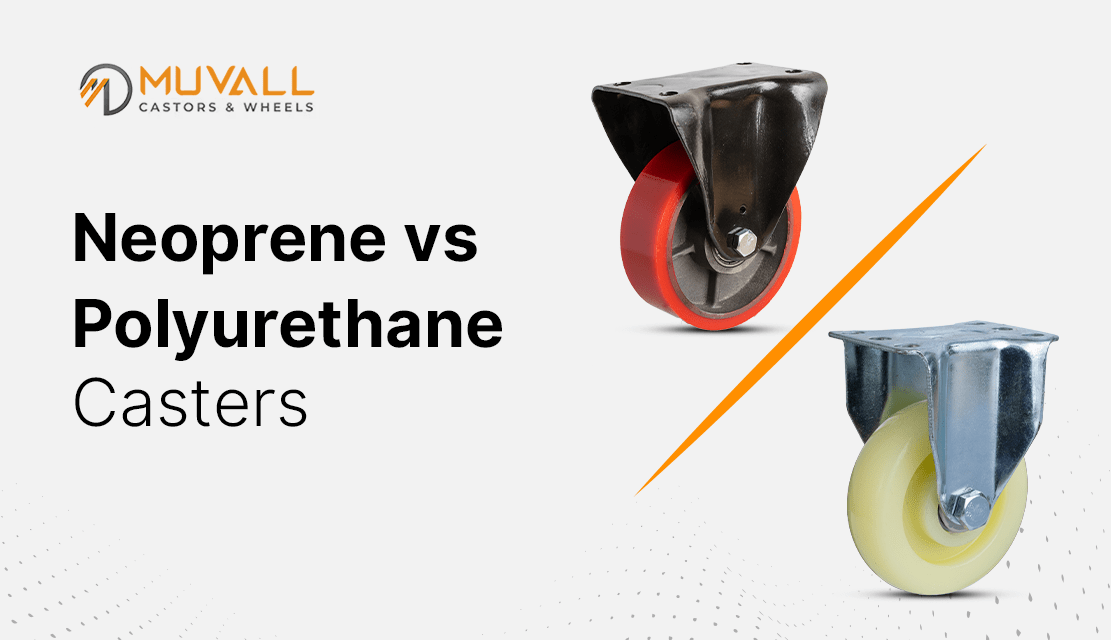
Traditionally, there were not many options for caster wheel materials. However, technical advancements in synthetic materials such as plastics have resulted in an explosion of choices. Two rubber-like synthetic materials- Neoprene and polyurethane replaced natural rubber.
Both neoprene rubber and polyurethane casters have their own unique characteristics and benefits. They both are suitable for different applications, and the decision of which caster to choose can significantly impact performance. In this blog, we will discuss neoprene vs polyurethane to help you make an informed decision.
Casters are wheels that are attached to different types of equipment or furniture that allow them to move smoothly. They come in various materials, each offering distinct advantages depending on your needs. Polyurethane and neoprene rubber are amongst the two most popular caster wheel materials. Let us discuss them both in detail:
Polyurethane is a synthetic rubber material known for its durability and flexibility. It is a versatile polymer that is made by combining solutions of 2 or more chemicals. The casters made from polyurethane material are often used in applications that demand resistance to wear, impact and chemicals. That is because PU casters can resist oil, grease and chemicals quite well.
Polyurethane is a strong material that is highly resistant to abrasion and can withstand heavy loads without wearing down quickly. Since it lasts longer, it can save you money in the long run for your equipment. It makes polyurethane casters ideal for use in high-traffic areas or environments where casters will be subject to heavy use.
Polyurethane caster wheels offer a smooth and quiet rolling experience. They help reduce noise levels compared to other casters by gliding effortlessly across most surfaces. Moreover, these casters can support a wide range of weights. So, whether you are moving large machinery or industrial equipment, PU caster wheels will surely offer smooth operation.
Polyurethane casters are less likely to leave marks, slip or crack. Not only this, but these casters also grip the ground better, which ultimately helps prevent accidents at work. These factors make polyurethane caster & wheels much safer than traditional rubber and plastic alternatives and a good option for environments with delicate flooring.
Related: PU Caster Wheel: Why Use It in Industrial Applications?
Polyurethane wheels can become less flexible in extremely low temperatures and might wear down when exposed to cold temperatures for a long time.
Due to their durability and the specialized manufacturing processes involved, Polyurethane can be more expensive than other types of casters.
Neoprene is also a type of synthetic rubber known for its flexibility, resilience and resistance to environmental conditions. It is made by chloroprene polymerization, which gives it a unique set of properties.
Casters made from neoprene rubber are highly resistant to grease, oils, high temperatures and harsh chemicals. They are often used for their ability to handle specific environmental challenges.
Neoprene casters offer good resistance to harsh chemicals, grease, oil and animal fats. This makes it ideal for medical and light-industrial applications where exposure to harsh chemicals is common.
Moreover, neoprene rubber casters can perform well in a range of temperatures. That is because the material can maintain flexibility and resilience in both hot and cold environments better than other caster materials.
Neoprene wheels are known for their smooth and quiet operation. They are much quieter than plastic and cast iron casters. It makes neoprene rubber casters a great choice for office environments, medical carts, mobile computer equipment, etc.
Generally, neoprene rubber casters are more affordable compared to polyurethane caster wheels. It means these casters are a budget-friendly option.
Although neoprene rubber is durable, it is not as abrasion-resistant as polyurethane. It can wear down faster over time in high-traffic areas.
Neoprene casters may not withstand as much load as polyurethane caster wheels. Therefore, consider investing in polyurethane caster & wheels if you want casters to support hefty loads.
Both polyurethane and neoprene rubber caster wheels have their own set of advantages and disadvantages, and both have come a long way since the 1930s. Today, due to their superior properties, they have completely replaced natural rubber as a choice for caster wheels. They are widely available in different styles. It means that when it comes to choosing caster materials, you have many options to meet your specific demands.
To make an informed decision about which caster material is best fit for your application, all you need to do is carefully consider your specific needs. It includes load capacity, surface type, budget and environmental conditions.
No matter which caster you choose out of the two- polyurethane or neoprene rubber, the right caster will surely enhance the functionality and longevity of your equipment or material!
Also Read: Polyurethane Vs Polypropylene Wheels: The Right Choice For Industrial Caster Wheels
Frequently Asked Questions (FAQs)
Ans. Here are some factors to consider when deciding between polyurethane and neoprene rubber casters:
Determine the weight of the items being moved. Polyurethane caster wheels are a better choice than neoprene rubber casters for heavy-duty applications. On the other hand, if you want casters for light loads or less demanding environments, neoprene rubber wheels are also a good option.
Assess the surfaces the casters will roll on. While polyurethane is best suited for hard surfaces, neoprene rubber casters are well suited for uneven or rough surfaces.
Although neoprene rubber casters typically offer a more economical solution, polyurethane caster & wheels are a good choice if you need a long-lasting and high-performance solution. So, if you are willing to invest more, polyurethane is a solid choice.
Ans. Yes, neoprene rubber is generally a safe caster wheel material. If we talk about neoprene rubber caster wheels, they are not only durable but are also resistant to oils and chemicals. However, you must only use these casters within their load limits to ensure optimal performance and safety.